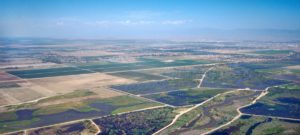Richard Frank writes,
“The California Court of Appeal for the Third Appellate District has issued an important decision declaring that California’s powerful public trust doctrine applies to at least some of the state’s overtaxed groundwater resources. The court’s opinion also rejects the argument that California’s Sustainable Groundwater Management Act (SGMA) displaces the public trust doctrine’s applicability to groundwater resources.
The Court of Appeal’s opinion in Environmental Law Foundation v. State Water Resources Control Board decides two key issues of first impression for California water law: first, whether the public trust doctrine applies to California’s groundwater resources; and, second, if it does, if application of that doctrine has been displaced and superseded by the California Legislature’s 2014 enactment of SGMA. A unanimous appellate panel answered the first question in the affirmative, the second in the negative. … “
Read more from the Legal Planet here: California Court Finds Public Trust Doctrine Applies to State Groundwater Resources
Timothy Parker and Graham Fogg discuss the benefits and the challenges of Managed Aquifer Recharge, and how MAR can be key to water security in a changing climate
From Maven’s Notebook:
 Groundwater is an essential water source, providing 35% of the fresh water used in California, and significantly more in drought years. However, when groundwater is used more rapidly than it is naturally replenished, actions must be taken to correct the imbalance, and one of the tools used by groundwater managers is managed aquifer recharge (or MAR).
Groundwater is an essential water source, providing 35% of the fresh water used in California, and significantly more in drought years. However, when groundwater is used more rapidly than it is naturally replenished, actions must be taken to correct the imbalance, and one of the tools used by groundwater managers is managed aquifer recharge (or MAR).
Managed Aquifer Recharge (MAR) enhances the recharge rate by creating artificial streams and ponds where water trickles into the ground, or by using wells to directly inject water underground. MAR can also be used to improve groundwater quality and prevent some of the negative consequences of groundwater depletion, like ground sinking (subsidence) or the intrusion of salty groundwater from the oceans into coastal freshwater aquifers.
In an American Geosciences Institute webinar, Timothy Parker, principal hydrogeologist at Parker Groundwater, discusses managing groundwater storage and managed aquifer recharge in California. Next, Graham Fogg, from UC Davis discusses recharge and reservoir management and keys to water security.
Read more at Maven’s Notebook here: Managed Aquifer Recharge in California
From Maurice Hall at EDF’s Growing Returns blog:
“The Cosumnes River is one of the last undammed rivers west of the Sierra Nevada. While not a large river, it flows year-round out of the Sierras, east of Elk Grove, south of Sacramento, and across the floor of the Central Valley before adding its modest flow to the Mokelumne River.
Every year, however, around the Fourth of July, the lower part of the Cosumnes River goes dry, even while the flow from the Sierras continues. The lower river stays dry until the first big rains come, sometimes as late as December or January, and resumes its high flow throughout the winter months.
How can a river be flowing and then disappear downstream? The explanation lies in the inevitable interaction between groundwater and surface water, which have been managed separately – until now. … “
Click here to read more from the Growing Returns blog.
From Maven’s Notebook:
 “Flood-MAR is an integrated water resource management strategy that uses flood waters resulting from rainfall or snowmelt for managed aquifer recharge on agricultural lands and working landscapes. Flood-MAR can also be implemented at multiple scales, from individual landowners diverting flood water with existing infrastructure to using extensive detention/recharge areas and modernizing flood management infrastructure and operations.
“Flood-MAR is an integrated water resource management strategy that uses flood waters resulting from rainfall or snowmelt for managed aquifer recharge on agricultural lands and working landscapes. Flood-MAR can also be implemented at multiple scales, from individual landowners diverting flood water with existing infrastructure to using extensive detention/recharge areas and modernizing flood management infrastructure and operations.
With the implementation of the Sustainable Groundwater Management Act as well as the effects of climate change necessitating changes in how water is managed in California, Flood Managed Aquifer Recharge, or Flood-MAR, potentially presents a sustainable strategy that can simultaneously accommodate longer and deeper droughts along with more severe and frequent flooding.
In a July 2018 webinar, Kamyar Guivetchi, Manager of the Division of Statewide Integrated Water Management with the California Department of Water Resources (DWR), discussed the importance of the Flood MAR concept and what DWR and other state agencies are doing to advance the concept. … “
Click here to read this article at Maven’s Notebook.
From Ellen Hanak and Jelena Jezdimirovic at the PPIC Blog:
“Last summer, some 250 local groundwater sustainability agencies (GSAs) were formed―the first step in meeting the requirements of California’s historic Sustainable Groundwater Management Act (SGMA). Now these agencies face the difficult task of developing and implementing plans to bring their groundwater basins into balance over the next 20 years.
A recent event by the Groundwater Resources Association of California explored groundwater governance, and laid out ways that locals will need to cooperate to manage groundwater for long-term sustainability. Here are four key takeaways. … “
Continue reading at the PPIC blog by clicking here.
From Maven’s Notebook:
“In 2014 California enacted the Sustainable Groundwater Management Act (SGMA) which mandates that areas that depend upon groundwater achieve sustainability by 2040. Meeting the requirements of SGMA will mean a net reduction in groundwater overdraft of about 2 million acre-feet per year. The social, economic and environmental consequences—intended or otherwise—of this change in water policy are vast.
Dr. Jeffrey Mount is a Senior Fellow with the Public Policy Institute of California Water Policy Center. In this keynote speech given at the Groundwater Resources Association’s Groundwater Sustainability Plan Summit, Dr. Mount argued that the state needs to take a comprehensive look at what it is going to take to achieve groundwater sustainability and develop pathways that minimize or mitigate unwanted effects. He also noted that his speech would draw on the work of his colleagues at the Public Policy Institute of California’s Water Policy Center who have been working on the San Joaquin Valley to envision a future for the Valley under SGMA and what the consequences would be. … “
Continue reading at Maven’s Notebook by clicking here.
From Alvar Escriva-Bou at the PPIC Blog:
“The wet winter of 2017 brought an opportunity to test groundwater recharge—the intentional spreading of water on fields to percolate into the aquifer—as a tool for restoring groundwater levels and helping basins comply with the Sustainable Groundwater Management Act (SGMA). This is especially important in the San Joaquin Valley, which has the biggest imbalance between groundwater pumping and replenishment in the state.
A key question for many valley water managers is how much water will be available for recharge in the long term. By law, only river flows in excess of what is required for environmental purposes and to supply existing water-right holders are available for recharge. A recent report by the PPIC Water Policy Center estimated how much water would be available in the San Joaquin Valley over the long term. Two earlier studies—one by two scientists at UC Davis and the other by the Department of Water Resources—estimated a maximum of about half a million acre-feet on average, which is about a quarter of the valley’s estimated deficit. The PPIC study updated these estimates in the context of current conditions and concluded that an average of more than a million acre-feet of San Joaquin River flows may be available. … “
Read more from the PPIC Blog by clicking here.
From Ellen Hanak at the PPIC Blog:
“California is a force of nature when it comes to almonds. The state’s farmers produce virtually the entire US almond crop and dominate the international market. As the market has grown, almonds have become California’s largest single crop—now accounting for about 12% of irrigated acreage, with more than 1.2 million acres harvested in 2016. Availability of water is clearly a major issue for the industry, since the trees must be irrigated throughout the long spring and summer dry season. At a May event on water issues organized by the Almond Board of California, I was asked for some thoughts on the water realities almond growers must grapple with in coming years. Here are three key takeaways. … “
Continue reading at the PPIC Blog by clicking here.
From Jelena Jezdimirovic at the PPIC Blog:
“The San Joaquin Valley is ground zero for groundwater management challenges. While agriculture is the region’s predominant water user, its cities are more likely to rely on groundwater as their primary source of water. For this reason, the urban sector will need to play a bigger role in the regional effort to balance groundwater use and replenishment.
Our recent research indicates that cities in the valley lag behind agricultural districts in the intentional recharge of groundwater. That’s primarily because most have limited access to two things necessary for storing more water underground: extra surface water and unpaved land on which to spread it so it can percolate into the ground. But some cities have had success with recharge activities. Here are three methods that can serve as models. … “
Continue reading at the PPIC Blog by clicking here.
From Ellen Hanak at the PPIC Blog:
“Last week a diverse group of stakeholders celebrated the tenth anniversary of the Lower Yuba River Accord—a historic agreement to improve conditions for the river’s endangered fishes, maintain water supplies for cities and farms, and reduce conflict over competing uses for water. Here at the PPIC Water Policy Center we frequently refer to the Yuba Accord as a model for modern water management in California. Here are three reasons why. … “
Continue reading at the PPIC Blog by clicking here.


